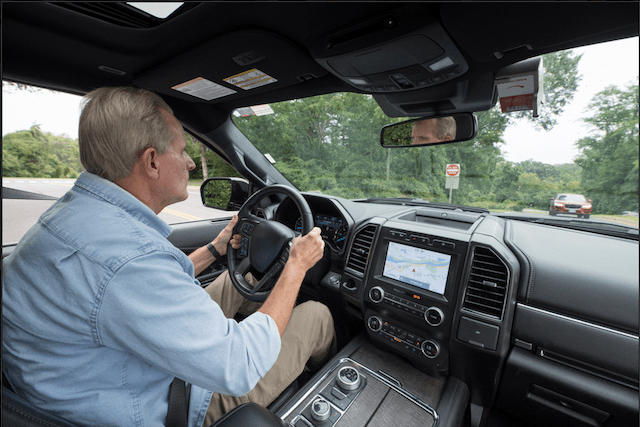More older drivers are on the roads today than ever before – there are 49.6 million drivers in the United States age 65 and older as of 2021, according to the most recent report from the National Highway Traffic Safety Administration. That was a 38% increase from 2012, compared to just a 10% bump in the total number of licensed drivers.
But along with that growth has come a sharp increase in traffic deaths. The number of fatalities in senior driver crashes nationwide reached its highest point in more than 20 years.
“Older drivers aren’t necessarily worse drivers than their younger counterparts,” said Mark Schieldrop, Senior Spokesperson for AAA Northeast. “In fact, AAA research shows that seniors are less likely to engage in risky behaviors behind the wheel. But they are at greater risk of being killed or seriously injured if a crash occurs.”
Remaining an active driver can provide older adults with a much-valued level of independence. However, the physical and cognitive changes that come with aging, coupled with medical conditions and increased medication use can put older drivers at a greater risk behind the wheel.
AAA Northeast is encouraging seniors and their families to have discussions about how to ensure safe mobility for years to come.
Here are some of the biggest challenges older drivers face and how to overcome them.
Vision Problems
Just about everyone’s eyesight gets worse as they age thanks to a condition called presbyopia. Over time, the lenses in your eyes stiffen, making it more difficult to focus on nearby objects. Other diseases, such as glaucoma, cataracts and macular degeneration, can exacerbate the problem.
On the road, vision problems can make it difficult to see pedestrians, cars, signs and hazards, especially at night or in low-light conditions. A study conducted by the Insurance Institute for Highway Safety found that one-third of crashes involving older drivers were the result of inadequate surveillance, mostly looking but not seeing another vehicle or traffic control.
Hearing Loss
Hearing loss is another common problem for older adults, and though we might not think of hearing as a critical sense for driving – it is. Recognizing horns and sirens can help you steer clear of danger and avoid a crash.
Sore Muscles and Joints
As you age, your muscles may become weaker and your joints stiffer. Arthritis, or joint inflammation, is particularly common in older adults. It can be painful to move afflicted parts of your body, making it difficult to pull off even the most basic physical movements needed to drive a car safely, such as turning the steering wheel, applying pressure to the brake or accelerator and turning your head to see your surroundings.
Medications
Research from the AAA Foundation for Traffic Safety found that nearly 50% of older drivers were using seven or more medications. Many medications come with potentially impairing side effects, such as blurred vision, confusion, fatigue or incoordination. Symptoms like these can increase the likelihood of a crash by up to 300%.
Slow Reaction Time
Reflexes tend to slow down as you age, making it difficult to react to sudden changes on the roadway in a timely manner. This can put you at a greater risk for a crash.
Traffic Difficulties
Studies have shown that older drivers have more trouble with specific aspects of driving. These include merging, passing through intersections and judging the space between vehicles and the speed of other cars.

How Older Drivers Can Remain Safe Drivers
- Talk to your doctor. Have an honest conversation with your doctor regarding your health and whether or not it’s safe for you to drive. You may also want to devise an exercise program under their guidance to increase your strength and flexibility.
- Ask about side effects. According to the AAA Foundation for Traffic Safety, many drivers prescribed potentially impairing medications are never warned by their health care provider about how the medicine could impact their driving ability.
- Get your eyesight checked regularly. Your vision changes as you age, so make sure to visit your eye doctor at least once a year. Never drive without wearing your prescribed glasses or contacts.
- Be smart about when you drive. If possible, avoid driving at dawn, dusk or nighttime. The limited light and/or sun glare during these times of day make it more difficult to see. You also may want to make things easier for yourself by avoiding the road during rush hour and other times of high traffic.
- Take an adult driving lesson. Learning how to drive is not just for teenagers. Whether you’re a brand-new driver or just need a refresher, it’s never too late to improve your skills behind the wheel. As always, AAA is here to help. Learn about our Adult Driver Training program and sign up today!
- Adapt your vehicle. Hand controls can allow you to operate the brake and accelerator with handles, which you may find easier than using your feet. Seat boosters can give you a better line of vision from behind the wheel.
- Learn about AAA’s CarFit assessments:
Learn more about AAA’s senior driving resources, including information on how older drivers can extend their driving careers and prepare for “driving retirement.”
Are you an older driver? What are some challenges you’ve encountered behind the wheel? Let us know in the comments below.
This article has been updated and republished from a previous version.
59 Thoughts on “Top Challenges for Older Drivers”
Leave A Comment
Comments are subject to moderation and may or may not be published at the editor’s discretion. Only comments that are relevant to the article and add value to the Your AAA community will be considered. Comments may be edited for clarity and length.















Headlights on new cars and trucks, are brighter, and placed higher, requiring regulation of the lumens and placement.
yellow glasses are needed to mitigate the night blindness from the new auto headlights, these lights should be banned from being on highways, parkways, expressways, etc.
RX yellow glasses should be regulated and rated for to their ability to reduce the intensity of headlights, in autos employing high-lumen lights/bulbs, including the placement of those lights.
I was a driver safety course instructor. While all of your pointss may be valid, you neglected to mention tailgaters w3ho wish to go 65 in a 45 mile zone and the increasing number of drivers passing illegally on the right
Hi
Nighttime is horrible for older drivers. Everyone gets presbyopia. I suffer from this.
Combined with rude, distracted and aggressive drivers today, you have to drive defensively. We need more law enforcement on the roads!
It is very easy to lose your concentration whilst driving. We need to concentrate on where we are going. Not to miss turns. Your mobile phone can give you precise instructions door to door. To concentrate, avoid conversation with your passenger. Stay alive.
According to IIHS statistics, in 2021, the motor vehicle death rate (deaths per 100,000 persons) for those aged 70 and over was 13.9. For those 20-34 it was 19.0. For those 35-69 it was 14.3. So which age group has a driving problem?
I previously held a position as Traffic Supervisor in my town and found that 90 % (just my estimation) of fast drivers were the very young drivers (ages 20-30). They seem to lack the ability to control their need for speed and/or enjoy going fast. Also, they seem to be easily distracted also showing an inability to concentrate on their driving. I feel that these two areas are critical to Driver’s Education, yet may be lacking. I have also noticed that drivers over 65 yo have difficulty with the brightness of some vehicles’ headlights. Sometimes wiping out their vision entirely, however mostly seeing “starbursts” that make it very difficult to see at night. Most older people are wise enough to stay off the road at night for this reason and slippery conditions.
You made the statement that you noticed drivers over 65 years old have problems with the brightness of headlights. My many conversations with drivers of most ages tell me ALL of them have problems with the newer headlights some lights being worse then others. I would suggest you do a little more research on your comments before you pick out certain age categories.
definitely these newer head lights They are blue white and blinding and I am pretty sure its not just the seniors
In reference to this statement, I don’t believe in this article because I am over 50 myself and the way these young people drive they are tailgating like crazy. Also, our government is tying up the hands of the police are doing their job and I know this short backed up talking to a lot firefighters policeman, and they all tell me the same thing, especially in Massachusetts. The government is tying hands up of the law enforcement offices. But they need to do is back up the police and let them do their job. You pedestrian walking in front of cars going to greenlight. The cars are running red lights because the police are afraid to do their job because of our government. It’s time we get back to basics and let the alarm enforcement offices do their job and also protect them.
One big help as I drive at night is to make sure that my windshield is clean and that my wipers are non streaking. Further, I try to look as far ahead as I can and make sure I am as far away from the middle of the road as safety will allow. It also helps to keep the instrument panel as dark as you can stand. (Keep your glasses clean too!)
The major problem with high beams, whether LEDs or other technologies, is not your own, assuming you are a responsible driver, but the other guy’s. As we all know, it can be blinding on a two lane road when and oncoming car does not dim its lights. This behavior can and does cause fatal accidents. In some European countries it is illegal to drive with bright beams on in the face of oncoming traffic. And I understand that this law is actually enforced in France with a stiff fine for violation.
So true! Especially when you are in a sedan (like me) and the other vehicle is an SUV. Automotive designers should design the headlights so that they point to the road not the oncoming driver.
I have found yellow clip on lens covers to be helpful with glare. There are polarized versions but I have not tried them.
Where can polarized versions of the yellow lens be obtained? Just curious.
Rotaries or circles with two lanes are abundant in Florida. Those drivers on the inside lane wanting to exit the circle can cut in front of you. They are dangerous and few know how best to handle them..especially older drivers accustomed to stop 🚥 from the
Northeast.
I notice the number of comments that refer to overly bright LED headlights. It could be drivers traveling with high beams. My new Pacifica has auto-dimming feature that senses approaching lights and switches off the high beams. This feature is a must have, because if you blind an on-coming car, you may be the one it hits. Also, every vehicle inspection should include a check for correct headlight aim. It is clear from these comments that it is extremely important. BTW – I also find over-bright headlights to be an irritant while driving. Finally, cataracts in ageing eyes scatter light terribly. I have had mine fixed — it is a fairly straight-forward procedure and has improved my night vision tremendously. Everyone gets cataracts as they age, and if you are over seventy, you need this operation.
It’s the LED lights! If you need to drive with your high beam lights on all the time-you need to give up driving at night-I’ve been night blind since I got my license – in the mid eighty’s!-I would love give up driving-but, I need to work for a living. As for everyone over 70 needing cataracts-my parents don’t have cataract-over 80 and do not drive at night
I find that newer vehicles with auto LED high beams blinding as they do not auto dim until they are within 5-10 feet of you. Also when driving ahead of a car with auto LED high beams they are so blinding in my rear view mirrors. Especially irritating is when at a traffic light and the car across the intersection has the auto high beams on.
Another suggestion for older drivers is to remove that handicap placard from your rear view mirror unless you’re parked in a handicap spot. I wish the police would enforce that more. Driving with that still attached to your mirror definitely obstructs your field of vision.
Extra bright LED headlights are a major safety hazzard for everyone, especially older drivers.
Also overly bright lights from parked emergency vehicles make it difficult to see anything but the lights themselves.
My problem with LED lights are the star burst effect, I feel like I’m on an episode of Star Trek going into warp drive. It is frustrating and dangerous. You get a group of cars such as at a traffic light and you can’t see anything. You have to drive looking away from the lights until they pass. I know this isn’t a new problem but I felt it was worth mentioning. Also this is a problem across the country, I’m hearing more and more complaints about this.
I recently drove from CT to TX,and the 3 biggest problems I endured were ,,,1 Glare from led headlights,,2 The amount of debris in the road, from ladders to full trash bags to bumpers that had fallen off,,even a mattress..3 Coming into Chattanooga TN on Rte 81,the quick changes in lanes from far right to far left to far right in 600 feet,,,its insane!!
LED lights should be made illegal, since they do often cause so many problems.
Racing develops driving skill, preserves mental and physical acuity and certain scary programs such as hill climbing, rallying, etc. that tickle the brain’s amygdala promote neuron regeneration in the senior brain, extending one’s ability to drive well beyond the norm. A program where one can plan. design and execute complex engineering to a satisfying long term conclusion also adds neurons to the pot, reversing the aging process. It is very important to be able to control one’s oxidative stress levels so wheel to wheel racing where other drivers can ruin your day are not as beneficial. In other words I can take my foot off the gas whenever stress got out of hand.
At age 76 I was routinely finishing on the podium in major events such as Giant’s Despair and Mount Washington, hitting 160 MPH on narrow, bumpy mountain roads. My reaction time was about 1/4 second and still is some 11 years later. I kept getting faster as I got older, but stopped racing only because my wife asked me to. I have driven to FL from New England 3 times without incident as an octogenarian. Oh I did get stopped in NC for cruising at 96 MPH by an unmarked cruiser. I told him I thought he wanted to race me and was waiting for him to catch up. The trooper laughed so hard when he discovered my age that he let me go with a verbal warning.
My achievements are not unique to me as I personally know of a half dozen other seniors who match or exceed my race performance. An 81-year old is still winning major events while another is a consistent podium finisher. One class winner was still winning and professionally driving an eighteen-wheeler well into his seventies. Use it or lose it!
Bette Davis said it best: “Old age is no place for sissies.”
Racing on the highway is unacceptable at any age. You may be fortunate enough to not get into an accident but certainly may be the cause of one or more because of your reckless behavior.
LED lights,especially on higher vehicles such as SUVs , blind drivers in cars as they approach.
The bright headlights hurt my eyes and I was unable to see the road clearly. I got a non glare coating for my eyeglasses and it really cuts the glare from the headlights.
Night driving is a major difficulty for me. Also, even in daylight, the center line, the lane lines and the fog line on the side of the road, if they have not been newly painted, cause me a lot of difficulty.
Definitely road lane markers need to be freshly painted this is a big problem in Massachusetts
I agree. The lines on roads are terrible – non-exsistent or very faint, hard to see on many roads in Massachusetts. I do not drive at night.
I find it the most difficult when the painted lines on the road are fading or missing altogether. Especially the one on the right side of the road. When oncoming traffic has the bright lights on, the line on the right side of the road is the only thing you can focus on at that moment.
Radar controlled safety assist features on the newer cars such as adaptive cruise control and brake assist have been very helpful to me; without them I would have had to switch to hand controls. Lane departure warning and blind spot warning can help prevent accidents for all drivers but especially so for older drivers.
I find that the yellow glasses or goggles made for night driving help me see better win the dark. They cut down the glare from oncoming traffic and somehow seem to make the night a little bit lighter. They are available as glasses or as “sun-shields” that go over your glasses.
Agreed, However all yellow lenses are not created equal. I own Several pair that serve a dual purpose when I drive my convertible in the evening.
They protect my eyes from wind, flying road debris, ( Bugs, Dirt), and they cut down on Glare.
The better ones actually enhance my visibility by making things brighter. The others cut glare but seem to cut out some of the illumination.
Suggest you try a few different pairs and utilize the ones that are best for you.
I have glaucoma, a field of vision defect and scar tissue on my right retina. It’s not only a challenge at night but with everything I do every day. Very frustrating while reading, but it’s here to stay and I have to make the best of it. I only drive places I know where I’m going at night because I can’t read street signs very well. When I do drive, I wear those “lovely” orange nighttime glasses, but they really do work. And someone above mentioned looking down and right when blinded….that helps you know where you are on the road since you can’t see much of anything but glaring lights when looking ahead. Even walking the dog at night I’m blinded by those LED lights. I just put a hand over my eyes like a visor and I can see where I’m walking. The challenges of growing older are many, but I’m thankful to be here and be as active as I am.
When you have to leave your car off for service, or have it inspected, when you return to your car, the seats height, space to pedals and steering wheel have all been changed. Often someone is waiting for you to move your car in a hurry as they need your spot. You must then readjust everything prior to getting on the road, and sometimes your extra seat cushion has been moved. We have to perform minutes of adjustments, just to get comfortable behind the wheel again. Often the tilt of the steering wheel has even been changed. I think service areas, inspection people, should be more aware that they are actually endangering their customers and should alert their employees to assist in making sure the seats and steering are back where they belong for the drivers. This would be a courtesy as well as a safety assist to all of our older drivers. For ex. I am 5 feet tall, use an extra cushion and had my seat perfectly adjusted, my steering wheel at the proper tilt for me. The inspection guy was about 6’7”. When I went to get back in my car. He said, just a minute I moved your seat, let me help you get it adjusted. I will definitely go back there for my next inspection. An extra 5 minutes can save lives.
Blaring, bright, blue lights from oncoming cars during sundown and night are the worst I’ve even seen in my life. Bright lights are on even though it’s not night and the blue lights create a halo around my eyes. I also dislike car lights that look like faces and then the pickups that are behind me don’t care that I’m blinded by their lights as they are situated higher up than my car. Rude, insensitive drivers dart back and forth and weave in and out of lanes if I prefer not to be intimidated by drivers who may be too young to be behind the wheel. However, one of the ways I’ve help myself during night is I got anti-glare glasses for distance and they help tremendously. I recommend them to everyone. I have my eyes checked every year by my opthomalogist and he always says I’m very lucky to have such good eyes. Keeping fit and forgetting about the PHONE and stop reading every turn on the GPS and looking at your surroundings is the best advice I can give. My grandchildren can’t drive without the GPS, so they never really know where they are. Look around, see your markers, know which way you’re heading, north or south, and be aware. Seniors got here without the GPS. I refuse to have one and still know how to read a map and know what direction I’m heading in.
As a runner, there are times when drivers will look for cars when making a turn, but not pedestrians.
Whenever possible, I back into a parking spot so I have clear visibility when leaving a location.
By the way, those glasses are for night driving and help with lights from other vehicles especially oncoming traffic.
Anti-glare, anti-reflective glasses help considerably. STRONGLY suggest educating yourself about what these terms mean before purchasing. Blue tint is not what you’re looking for. I got 2 pair online for less than $15. Very pleased with them and while they aren’t perfect, they definitely, definitely help.
I want to thank you for publishing other drivers’ comments and hopeful related auto driving suggestions to ameliorate their mentioned difficulties, I found it extremely helpful and at the same time reassuring. Thank you AAA. Marty Collins
night time Lighting is being mismanaged. For decades its been known that longer wavelength (yellow- orange- redder) lighting is better at night than simply brighter white lights. Ever since the LED craze, even though it purports to be more energy efficient, is worse at nighttime. This (white-blue) lighting performs even worse as the humidity rises. Higher energy lighting ( shorter wavelengths) tend to scatter more and cause the effect of glare and other distortion. Bridges “used” to be lined with yellow, orange or red colored lighting. for this reason (aircraft warnings around bodies of water). The rush to LED should have been delayed until the current “color tune-able LED lighting” was available. The new street lighting, all glare, is virtually useless. Check for your shadow next time your under one of these, and how fast it dissipates as you walk away, all glare.
My major concern about driving is driving at night. I have pretty much given that up. Fortunately my daughter is willing to pick me up if driving at night is required.
The biggest problem I encounter is oncoming headlights at night. It seems that more and more drivers use their high beams all the time – or headlights are much brighter than they used to be. It takes much longer for my eyes to readjust after a car passes with their high beams on – basically, I’m driving blind for a moment until my eyes readjust. With age, this is taking longer, so I may eventually have to stop driving at night.
I don’t understand this phenomenon, but it’s real. The NYT addressed this in a newsletter. Not only are drivers using high beams more and more often, auto manufacturers have been installing dangerously bright headlights. This is not so much a problem on major highways, but on two-lane roads, as I mentioned to a former traffic officer, there are times when I cannot see the road in front of me, anything in, on, or to the side of the road, or the car coming at me because the oncoming headlights are so bright. Moreover, the turn signals of an oncoming car can be bleached out due to the brightness of headlights. Because of this I find myself looking down and to the right to ensure that I am staying on the road, but this is an expedient, not a solution.
It is a fact that older people have an impairment of vision through lack of contrast, and through disability with low lighting, e g night driving .
There are simple tests for these very important issues but the medical profession dealing with vision does not use them. This should be part of eye testing for people over 65 . I would like to see AAA taking this up as a national issue.
Also everyone seeing a doctor gets their blood pressure measured. There should be a simple eye testing chart on the wall were the patient quickly reads the smallest line of print which is recorded. Their doctor can advise them, if necessary to go get a professional eye test.
I have two problems is driving at night. The first one is the lights from on-coming traffic. It seems to me that most cars seem to have led lights which are extra bright and they are blinding; I drive a sedan, which puts me at a disadvantage since everyone is driving suv’s and trucks and the lights on these tall cars hit my car light high lights. My second problem is that poor lighting in many streets. I try to avoid having to drive at night but it can become quite inconvenient.
I agree with your comment about SUV and truck headlights that are mounted so high that you are blinded by them if you drive a sedan. When SUVs started becoming popular, NHTSA proposed a regulation that would require that headlights on SUVs be mounted at the same height as on sedans. Unfortunately, this went nowhere (perhaps due to automobile manufacturers not wanting to change the designs of their vehicles). At the very least, the government could have required that the aiming of SUV or truck headlights be set to a lower level. I’d like to see AAA advocate for this.
So that problem and the fact that aging decreases seniors’ night vision, results in fewer nighttime trips. I try to schedule most of my driving during daylight hours.
That’s really not at all surprising. I’ve witnessed drivers who go way over the speed limit, cut others off, refuse to stop at STOP signs, run red lights, and cause horrible back-ups at intersections, especially during rush-hour, because they’re so anxious to get to where they’re going, and they bollux everybody else up. It’s disgusting. I’ve also seen drivers speed past drivers who they think are going too slow, and even cross the double yellow line(s) because they’re so anxious to pass. Boston’s Southeast Expressway is the most intense example of what goes on. People drive like they’re on the Indianapolis Speedway, and there are a lot of crashes on the Southeast Expressway, in part because of that. Moreover, it’s rush hour 24/7 on the Southeast Expressway, also.
I agree, all drivers, but especially older drivers, who obey speed limits and other traffic regulations but face dangerous situations from those who speed or drive recklessly, will benefit from enhanced enforcement of driving rules, including using speed cameras and other automated devices. But too many are unwilling to call for enforcement, out of privacy or civil rights fears, hostility to police, hostility to government regulation…
I drive on the “Mass Pike” (I-90) on Sunday mornings. No traffic. I’m usually going a little over the speed limit, and vehicles pass me like I’m standing still. And then they blast past the State Trooper parked behind the bridge ahead. I have NEVER seen one of these vehicles pulled over for speeding. They are probably going over 80 MPH. If the police won’t enforce the laws we have (i.e. stop signs, no right on red, turn signal usage, tailgating, driving erratically, speeding), there is an increase in accidents, which probably have a greater impact on older drivers.
You’ve made some good points that are well taken, Maggie. If the cops don’t enforce the laws, they’re just as much at fault as the ordinary, run of the mill drivers who violate them. The United States, in many ways, is becoming more and more like a third-world country; lawlessness here in the United States is on the up and up, and it has been for years–especially since 9/11.
AT 78, i am fortunate I still have good peripheral vision and good reaction . On several recent occasions, I have had drivers veer into my path as they suddenly decided to take a different direction at an intersection and cut directly into my path from the left. In one instance, the other vehicle came within a few inches of colliding with my car.
LED headlights are a huge problem at night. AAA should sponsor a study of how many accidents/pedestrian strikes occur at dusk/night on local roads. Then push the government to prohibit LEDs on new cars until the manufacturers can revise them to be safe.
That’s a damned good idea, Jean. Those LED Lights, especially the white ones, are extremely dangerous, especially because they impair the visions of anybody of any age, especially when people put their high beams on and refuse to dim them when passing drivers who are driving in the opposite direction,.
Sun glare is definitely an issue—for me it’s when the sun is low before dusk hitting the hood and windshield. Keeping the inside of the windshield free from the film that builds up is essential.
I’ve always had the same problems since I started driving at 16. Bad / Rude drivers that don’t follow the rules. I see people all the time not using turn signals, not fully stopping at stop signs, ignoring stop signs, texting on their phone. Honestly I’m over 65. Some people should have their license taken away because they’re not capable of driving. My opinion is they were always bad drivers and getting old exacerbated their poor driving habits.
Looking out for the other drivers can be a challenge. A safe driving class should not be an option, but mandatory.